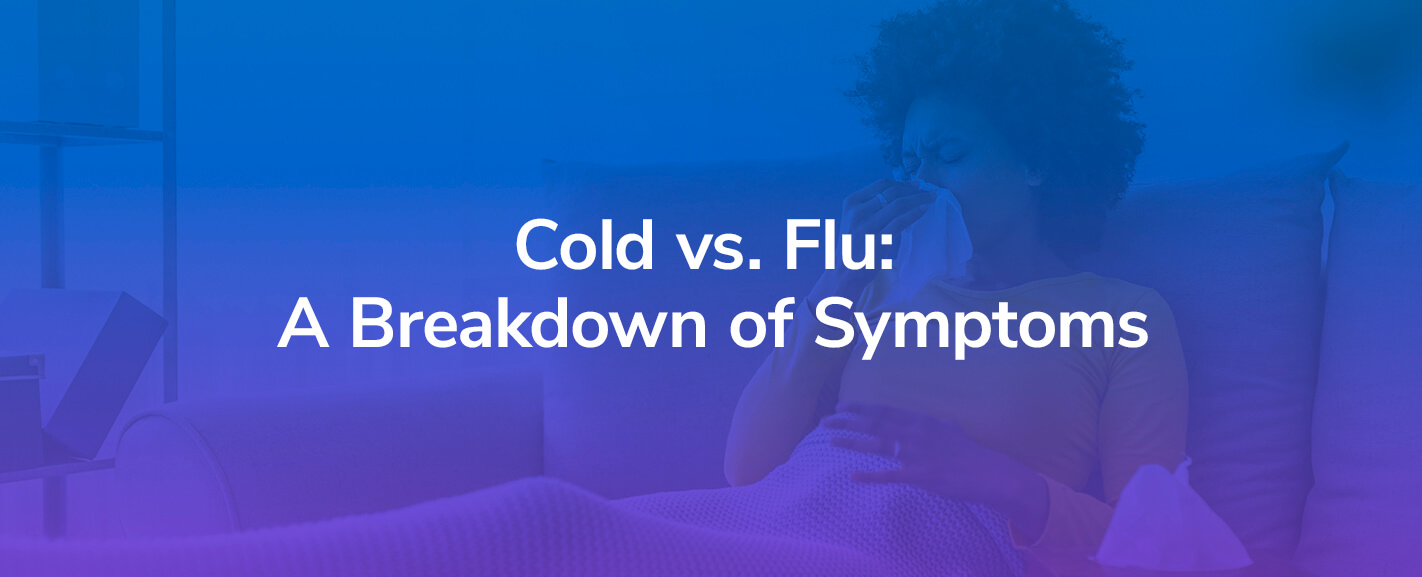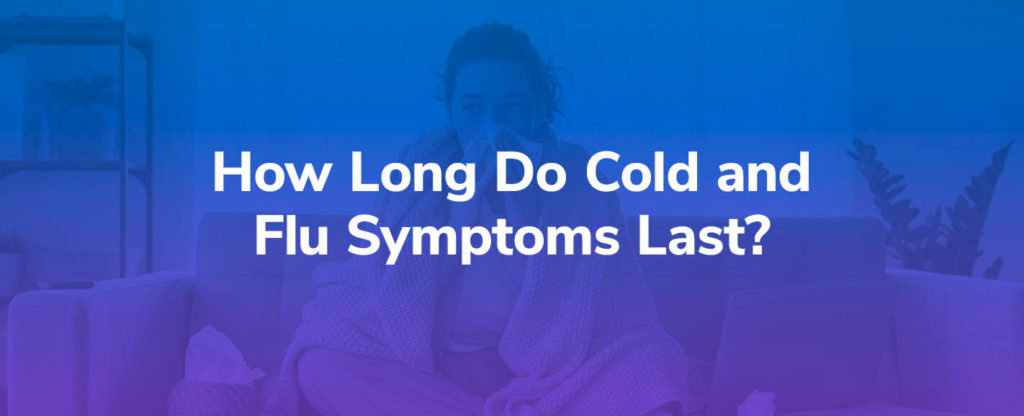The common cold and flu are both contagious respiratory infections. However, different viruses cause these infections. Various viruses cause the common cold, such as seasonal coronaviruses, parainfluenza or rhinoviruses. Rhinoviruses cause the majority of common colds. In contrast, the flu is exclusively caused by influenza viruses.
Table of Contents:
- Common Cold Symptoms
- Common Flu Symptoms
- Cold vs. Flu Timelines and Treatments
- When to See a Doctor
- How Mobile IV Medics Can Help
Since these two respiratory illnesses share many similarities, some people commonly conflate them. However, noteworthy differences separate the common cold from the flu. This article breaks down how cold symptoms differ from flu symptoms.
Common Cold Symptoms
Cold symptoms are milder than flu symptoms and don’t usually lead to serious health problems. Most people experience common cold symptoms for seven to 10 days, with gradual improvement after peaking around the fifth day. The three cold symptom categories are nasal, head and whole-body. Some cold symptoms occur briefly, while others, like a cough, runny nose or stuffy nose, can remain for the infection duration.
Here are some symptoms you may encounter when you have a cold:
Nasal Symptoms
Nasal symptoms occur inside your nose and upper respiratory tract. As an upper respiratory infection, the nasal region and upper respiratory tract are the common cold’s epicenter. Thus, many common cold symptoms are concentrated in the nose and sinuses. Some common cold nasal symptoms include:
- Congestion
- Loss of smell or taste
- Postnasal drip
- Runny or stuffy nose
- Sinus pressure
- Sneezing
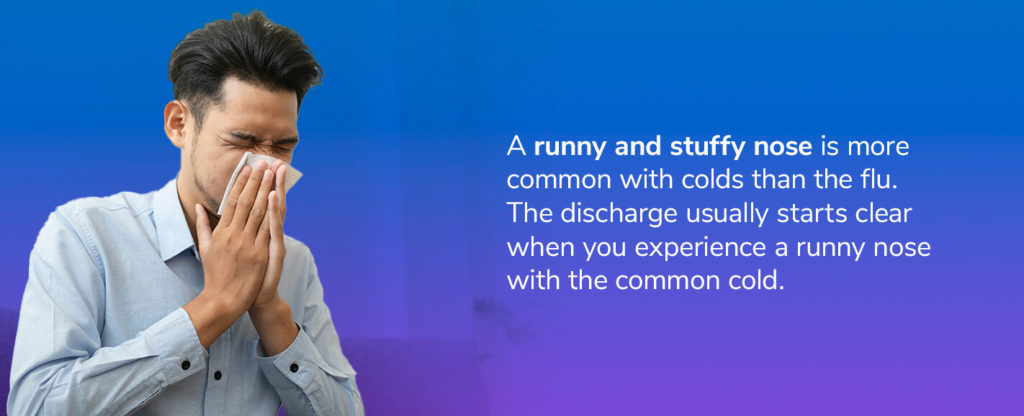
A runny and stuffy nose is more common with colds than the flu. The discharge usually starts clear when you experience a runny nose with the common cold. Eventually, it thickens and turns yellow or green as the infection runs its course. A runny nose functions to wash the virus from your nose and sinuses.
Head Symptoms
Unlike nasal symptoms, head symptoms occur anywhere on your head or face. Common cold symptoms occurring around your head and face include:
- Cough, often producing mucus
- Mild headache
- Sore throat
- Swollen lymph nodes
- Watery eyes
Whole-Body Symptoms
The body is a connected whole. So, although the common cold occurs in your upper respiratory tract, you can experience symptoms throughout your body. Here are some whole-body symptoms you may experience with the common cold:
- Chest discomfort
- Chills
- Fatigue
- Low-grade fever
- Slight body aches
- Trouble breathing deeply

Low-grade fever occurs when your body temperature rises above 98.8 degrees Fahrenheit but not beyond 100.6. This fever level isn’t clinically significant but is still a sign of infection. Fevers are more common with the flu than the common cold, as are chills and headaches.
Common Flu Symptoms
Flu symptoms are generally more severe than cold symptoms. Some common flu symptoms include:
- Chills and sweats
- Diarrhea and vomiting (more common in children)
- Dry, persistent cough
- Eye pain
- Fatigue and weakness
- Fever lasting three to four days
- Headache
- Moderate to severe muscle aches
- Runny or stuffy nose
- Shortness of breath
Often, the symptoms you experience are identical to common cold symptoms. Thus, testing is sometimes needed to determine the type of infection you’re experiencing. Still, the way you experience symptoms and the risks involved are generally different with the flu than with the common cold. The flu can lead to various complications, whereas the common cold rarely causes long-term health issues.
Some moderate flu complications include sinus and ear infections. More severe complications include pneumonia, sepsis, multi-organ failure and inflammatory illnesses like myocarditis or encephalitis. The flu can also worsen underlying conditions like asthma, chronic obstructive pulmonary disease (COPD) or chronic heart disease. Life-threatening flu complications are rare, but moderate to severe complications like sinus infections or pneumonia are comparatively common.
Cold vs. Flu Timelines and Treatments
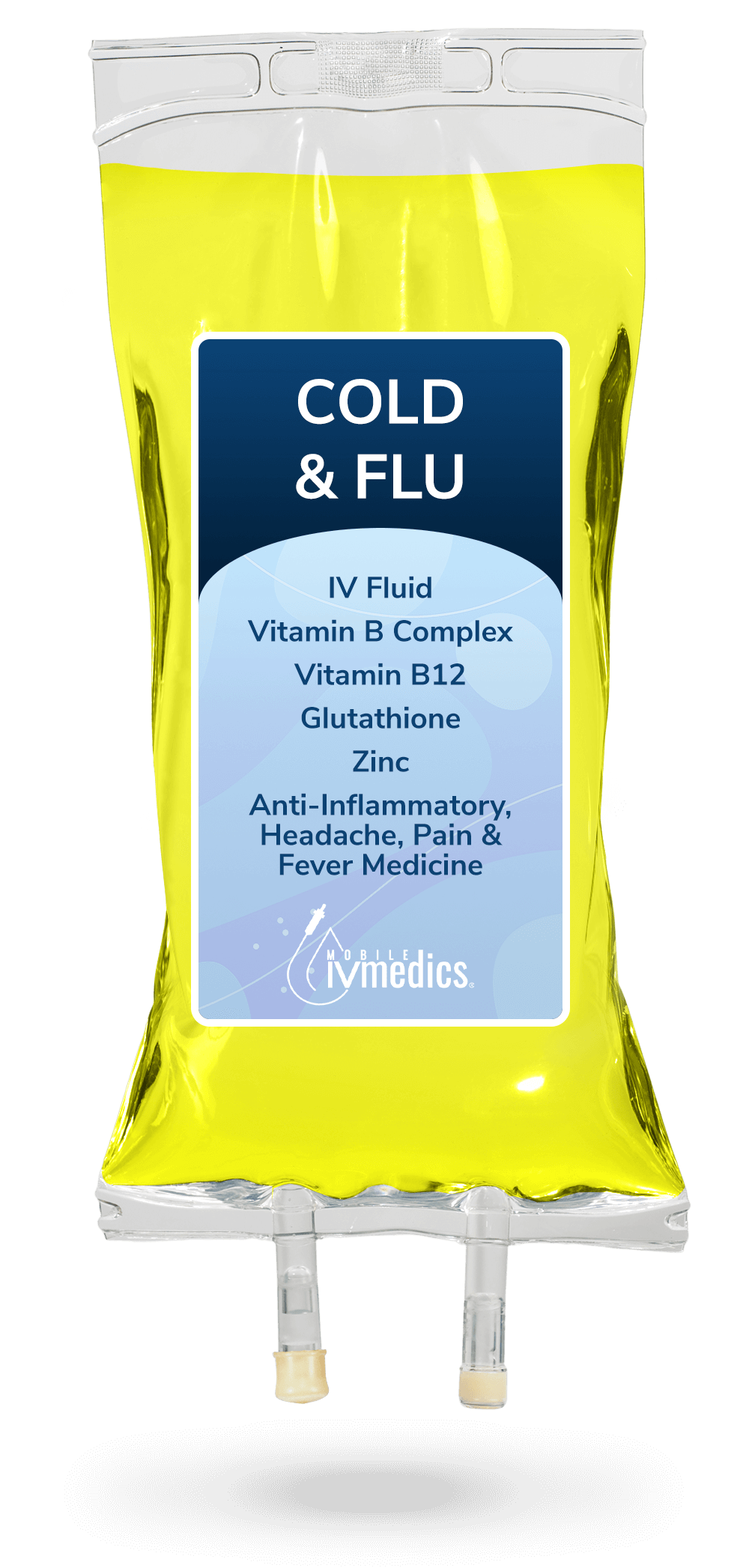
Other differences between the common cold and flu involve symptom timelines and treatment options. Even when identical symptoms occur, they usually appear at different times with the cold and flu. Moreover, flu treatment is often more necessary than treatment for the common cold because of the increased risks and severity.
With that said, here are some ways that the cold and flu differ concerning treatments and timeline.
Cold vs. Flu Timelines
One key difference between the common cold and flu is when symptoms present themselves. With the common cold, symptoms appear two to three days after infection and last two to 14 days. Influenza symptoms appear one to four days after exposure and last five to seven days.
Besides these slightly different timelines, flu symptoms appear much more abruptly than cold symptoms. So, with a common cold, you may notice a tingling in your throat or a slight cough for a day or two before you realize you have a cold. In contrast, flu symptoms often arrive suddenly and prominently.
The first symptoms of a cold are usually a sore throat and runny nose. These symptoms typically develop into coughing and sneezing. As symptoms progress, headaches and body aches are also common. Most people experience peak symptoms five days after beginning to feel ill.
Sudden and abnormal fatigue is commonly an early flu symptom. You may blame this on lack of sleep, working too hard or other causes until body aches and chills add to the symptom medley. As symptoms progress, you may experience a cough, sore throat, fever and nausea. For most individuals, nausea doesn’t lead to diarrhea or vomiting. You may notice exhaustion, fatigue and weakness for two to three weeks after coming down with the flu.
The contagious period for the cold and flu varies according to how long symptoms occur. Most people with the common cold or flu are contagious one day before symptoms appear and continue being so until the symptoms dissipate. As such, you may spread the flu before you know you have it. The flu is most contagious in the first three to four days of the illness. If you have a weakened immune system, you may be contagious for longer than usual. Young children may also spread influenza longer than the average individual.
If you experience a fever with either the cold or flu, it’s best to stay home for 24 hours after the fever reduces to limit the spread of influenza and other respiratory infections in your community.
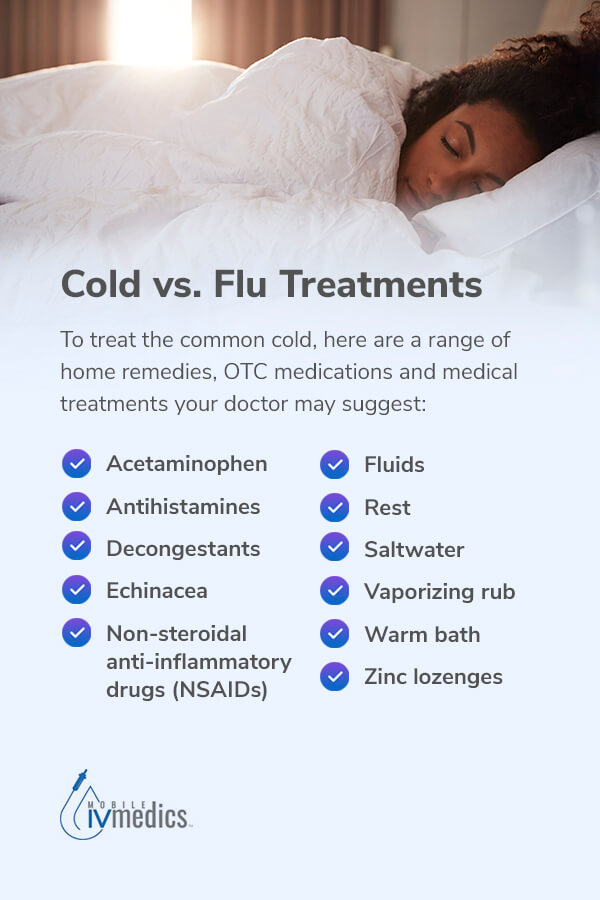
Cold vs. Flu Treatments
Common cold treatment often doesn’t extend beyond home remedies or over-the-counter (OTC) medications. Home remedy treatments for the common cold aim to relieve symptoms. Many flu treatments have the same objective, while others involve a more focused effort to help your body fight the infection. If either infection progresses beyond expected ranges, medical care may be necessary.
To treat the common cold, here are a range of home remedies, OTC medications and medical treatments your doctor may suggest:
- Acetaminophen: If you’re running a fever or have aches or pains, a sore throat or a headache, acetaminophen (Tylenol) can help.
- Antihistamines: Antihistamines are meant for allergies, but they can help with cold symptoms like sneezing and a runny nose. Examples of OTC antihistamines include Benadryl, Claritin, Allegra and Robitussin. Although prescription-grade antihistamines exist, they’re usually unnecessary for cold treatments.
- Decongestants: Decongestants clear nasal congestion by shrinking inflamed blood vessels in your nose. As such, they help with cold symptoms like a stuffy nose. Decongestants come in pills, liquids and nasal sprays and drops. Common decongestants include Dristan, Sudafed and Vicks. Like antihistamines, prescription decongestants are rarely needed for treating the common cold.
- Echinacea: Echinacea is a herbal remedy derived from a group of flowering plants related to sunflowers and ragweed. It’s used to decrease symptom severity and duration with respiratory infections, particularly when taken at symptom onset.
- Fluids: When you have a cold, you often lose fluids from blowing your nose or experiencing a fever. Drinking plenty of fluids will prevent dehydration and thin the mucus in your nasal passages, relieving a stuffy nose.
- Non-steroidal anti-inflammatory drugs (NSAIDs): NSAIDs like Advil, Aleve or Aspirin reduce inflammation and relieve pain. They can help with fever and body aches. Some NSAIDs are paired with a decongestant and can relieve nasal congestion.
- Rest: By resting, you give your body more energy and resources to fight the illness and let it run its course.
- Saltwater: If you have a sore throat with your cold, gargling with lukewarm salt water can temporarily relieve discomfort. Since salt attracts water, it draws fluids from the surrounding tissues. In this way, saltwater gargling pulls some of the bacteria causing the sore throat out of those tissues.
- Vaporizing rub: Topical products like Vicks VapoRub can ease congestion and open up airways.
- Warm bath: A warm bath can free up nasal pathways and airways and relieve muscle aches.
- Zinc lozenges: If you take zinc supplements within 24 hours of symptom onset, they may reduce symptom duration and severity.
Common cold home remedies also apply to flu treatments. Often, those home remedies are even more important for treating the flu. Besides home remedies, flu treatments often require antiviral medications.
These antiviral medications are known as neuraminidase inhibitors. Neuraminidase is one of the proteins that make up influenza viruses. As such, flu treatment antiviral medications inhibit the activity of essential proteins in the virus composition.
Some of these antiviral medications include:
- Rapivab: Rapivab, known medically as peramivir, is a prescription medication administered through intravenous (IV) fluid.
- Relenza: Also known as zanamivir, Relenza is an inhaled medication. Individuals with chronic respiratory diseases should not take Relenza for flu treatment.
- Tamiflu: Tamiflu, or medically known as oseltamivir, is an oral antiviral medication.
- Xofluza: Xofluza, or baloxavir marboxil, is also an oral antiviral medication.
When to See a Doctor
Most cases of the common cold and flu don’t require medical attention. That said, the flu requires medical attention more often than the common cold. If you start experiencing severe symptoms with either illness, it’s time to see a doctor. When severe or concerning symptoms happen with the cold or influenza, it’s often a sign of a bacterial infection or other secondary infection.
Some specific signs you should see a doctor for cold or influenza symptoms include:
- High, persistent fever: If your fever lasts longer than three days, you may be dealing with a bacterial infection that requires antibiotic treatment. You should also see a doctor if you have a fever higher than 103 degrees Fahrenheit. If you also experience a severe headache, rash, stiff neck, chest pain, difficulty breathing, confusion or abdominal pain with a high fever, seek immediate medical attention.
- Painful swallowing: Severe pain while swallowing may indicate strep throat, which usually requires antibiotic treatment because it’s a bacterial infection. It’s normal to experience discomfort while swallowing with a sore throat. If the pain worsens and hinders your swallowing ability, you likely have strep throat. Other signs of strep throat include white patches at the back of your throat.
- Unrelenting cough: If you have a cough that lasts longer than two to three weeks after coming down with the cold or flu, you may be dealing with bronchitis. As a bacterial infection, bronchitis requires antibiotic treatment. Other possible causes of a persistent cough after the cold or flu include postnasal drip or a sinus infection.
- Enduring congestion with headaches: If you continue to experience pain around your eyes and face with thick nasal discharge after one week, you may have a sinus infection. You should see a doctor in case you need an antibiotic to fight the infection.
Call 911 for emergency medical attention if you also experience:
- Severe chest pain
- Shortness of breath
- Dizziness
- Confusion
- Bluish skin color
- Persistent vomiting
How Mobile IV Medics Can Help
Whether you need to get back to work or just want to start feeling better, most people want to do whatever they can to decrease symptom duration and severity when they experience the cold or flu. Mobile IV Medics has a team of nurses prepared to deliver IV therapy services to you when you’re dealing with cold and flu symptoms.
Our services are 100% mobile, so all you need to do is pick up the phone, and we’ll bring the IV clinic to you! Since most people prefer to stay resting when they come down with the cold or flu, we’re happy to make treatment easier for you.
We have IV drip packages tailored to help people overcome cold and flu symptoms, including our Cold & Flu IV Drip. This drip package is packed with IV fluid, B and C vitamins, zinc, antioxidants and medication to reduce inflammation, headaches, pain and fevers. This potent concoction will help rehydrate you, boost your energy, strengthen your immune system and decrease symptom duration and severity.
We also offer hydration packages, immune support drips and other IV treatments that may help you overcome your infection. Feel free to add extra vitamins, amino acids, minerals or antioxidants at an additional cost to get the most out of your treatment.

Contact Us Today
If you’re feeling the effects of the cold or flu, let us help you at Mobile IV Medics. Contact us today and a professional from our team will be at your door shortly to provide you with the IV treatment you need.
Sources:
- https://www.cdc.gov/features/rhinoviruses/index.html
- https://health.catholic.edu/self-help/fever.html
- https://medlineplus.gov/commoncold.html
- https://www.health.harvard.edu/staying-healthy/how-long-does-the-flu-last
- https://www.cdc.gov/flu/about/disease/spread.htm
- https://mobileivmedics.com/what-is-iv-zinc-good-for/
- https://mobileivmedics.com/about-us/
- https://mobileivmedics.com/treatment/
- https://mobileivmedics.com/treatment/cold-flu/
